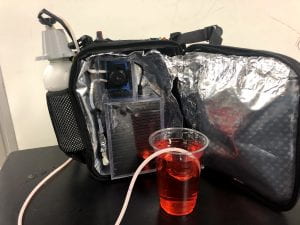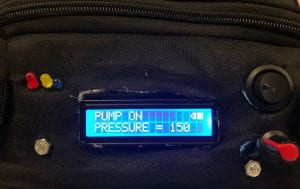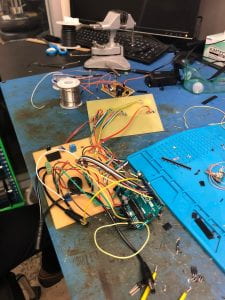This week was the most intense of all. We started off by making our second PCB: the one that separated the LCD/LED user interface from the main electronics. We spent a total of more than 8 hours trying to solder and re-solder it in order to troubleshoot connection issues and short circuits. This required extensive continuity tests on the board and powering the arduino with various power sources to check the potential source of the problem(s).
Once Friday night came along, we had run out of solder and had successfully completed our PCB. This allowed us to carry out battery-life testing during the weekend. We also placed the PCB in the chassis and secured it into place with nuts and bolts.
Monday came along and we were feeling invincible: our device was pretty much complete. All, we needed to do was carry out our tests.
As it turned out, testing was significantly more difficult and time consuming than expected: we could not use our Adafruit pressure sensor with our device as it was damaged, the pressure sensor we had ordered the week before had not yet arrived, we did not realize we would need an amplifier for our new sensor so we also had to wait for that to arrive, and we had to get 35 people to critique our device for alarm testing.
Alarm testing was time consuming but we managed to complete it after we asked people in the RMC to take a look at our user interface.
Durability testing required two team members to head to the BRC in order to use the shaker bed and verify that our device was able to withstand extended periods of shaking.
Other rudimentary tests -such as weight and volume- were easy to complete but we had not yet received our pressure sensor.
Our pressure sensor finally arrived on Wednesday. We tested it and it provided the same results as our vacuum gauge: the peristaltic pump was supplying too high of a pressure (almost -1kPa). This pressure would not change even when we adjusted the pump’s rotating speed. This is because the pump would simply compress the tubing in the inside until it would provide a constant flow-rate of tubing.
In the end, however, we managed to overcome this problem. We attached a check-valve to our tubing in order to let more air into the system but still prevent fluid from leaking out of the tube. This allowed us to control the pressure provided by the pump at a given rotation speed: we had managed to find a way to control the pressure and keep it within the range we wanted.
Working on this project taught me a lot about fluid mechanics, and electronics. However, I believe that I have also learnt a lot about design in general.
When we first started brainstorming, I doubted that the peristaltic pump would be our winning pump: I thought that we would go for a regular diaphragm pump as it had been tested by the previous team. In the end, the peristaltic pump turned out to be a crucial element of our final design. This showed me the importance of doing thorough research and looking at a wide range of existing solutions before trying to jump to problem solving: you cannot effectively evaluate all your options if you do not know what your options are.
I also learnt a lot about the process of evaluating ideas without being able to physically test them. When trying to determine which design to chose, we found it difficult to try to evaluate our proposed solutions as we could not carry out any physical testing. As a result, we were forced to develop constructed scales with which to try to gauge factors like durability, potential battery life, likeliness to leak and effectiveness at maintaining pressure. For example, for durability we looked at how much stress different cap materials could handle and compared the durability of the tubing in a peristaltic vs diaphragm pump. Based on this we could assume which pump and cap material would be more durable, and thus we were able to determine which overall design was likely to be more durable.
I think that one of my biggest realizations throughout the prototyping process was when we faced the issue of having too high of a pressure at the wound-site. I felt devastated. I thought that we had invested all this time into creating a complex PCB that could provide pressure controls and alerts, but in the end we wouldn’t even be able to supply adequate pressure. It would have been a major defeat: the device wouldn’t have been able to perform its main intended function. Even though we managed to overcome this issue, I think we could have felt less stressed by it if we had encountered it earlier on in the prototyping process.
Although we had carried out various tests with our medium fidelity prototype, all of them were solely intended to check whether the circuit was able to perform a single function: turn off when the float switch was pushed manually, increase/decrease pump speed with the potentiometer input, and blink LEDs. None of these tests truly tested whether the device had managed to meet the design criteria: it would not have mattered if the float switch worked with manual operation if we were then to put it in water and find out that the water could not push it. It would not have mattered if the pump could be throttled by the potentiometer if the pump was not capable of supplying the desired pressure. It would not have mattered if the LEDs blinked if the user had found the LEDs to be non-noticeable.
This showed me that what we should have been doing all along is test to see whether the criteria was being met: not if the device could perform a basic function. After all, the final goal is to fulfill the criteria, not achieve the functions that you think will fulfill the criteria.
It’s been good SEED,
Eduardo.




This is a most erudite blog! It shows you have done so much original thinking rather than following the paths of others. You have such a good mind and work ethic.
Your report delivered yesterday was well done, as you again showed your speaking skills. Your writing skills are also effective, as seen in your blogs. All in all, you are obviously a most outstanding student.